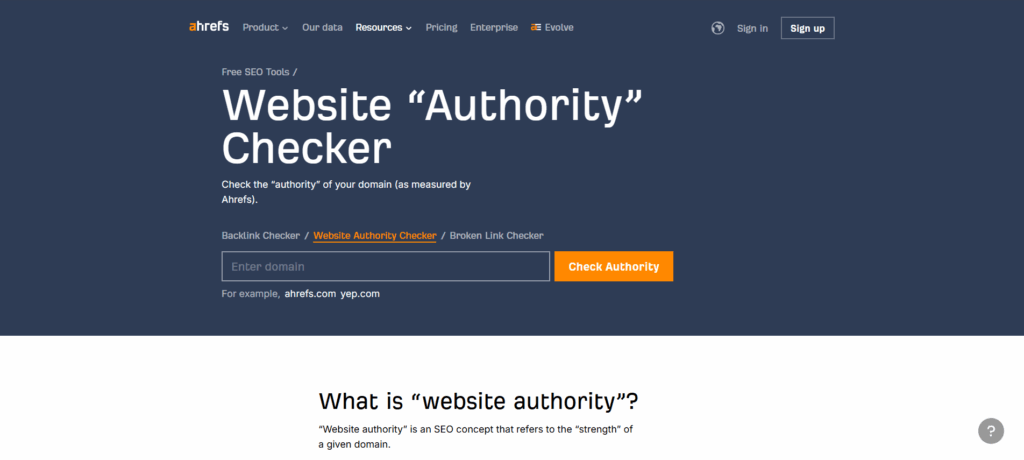
Domain Rating vs. Domain Authority: Which One Actually Moves the Needle?
If you’ve dipped even a toe into SEO, you’ve bumped into these two titans: Domain Rating (DR) from Ahrefs and Domain Authority (DA) from Moz.
Some marketers swear by one. Others switch sides mid-campaign. A few pretend they don’t use either (spoiler alert: they totally do).
But let’s cut through the noise. Do these metrics really matter? And more importantly, are you using them right or are you just playing the numbers game blindfolded?
Here’s what we’re about to unpack, without fluff, hype, or tool bias:
- What DR and DA actually measure
- Why these scores get misused all the time, by clients, SEOs and even link vendors
- How to apply them smartly in audits, link prospecting and outreach
- When you need to flat-out ignore both

Ready to stop letting metrics mislead you and start using them like a strategist? Let’s dive into the real score behind the scores.
So, What Exactly Are Domain Rating and Domain Authority?
Think of Domain Rating vs. Domain Authority as digital reputation scores, each built by a different architect, viewing your site through a unique lens.
They aren’t a part of Google’s inner algorithmic sanctum, but they’ve become the compass SEOs use to navigate the vast wilderness of link equity and authority.
Here’s the breakdown, simplified but not stripped of insight:
- Domain Rating (Ahrefs):
Imagine DR as a pulse check on a website’s backlink strength. It focuses on:
- The number of unique referring domains
- The authority of those links
- The velocity at which such links are acquired
- The number of unique referring domains
It’s your go-to when deciding whether a backlink is a trophy or just another trinket.
- Domain Authority (Moz):
DA, by contrast, plays a different game. It’s designed to predict rankings and not just weigh links. It considers:
- Site age and historical trust
- Link profile, including spam risk and link diversity
- Traffic signals (in some versions)
- Site age and historical trust
Think of it as a strategic report card to shpw clients where they stand on the SERP battlefield.
💣 Pro Tip: Use DR when building your link prospect list. Use DA when pitching progress to clients. Each metric speaks to a different part of the journey.
Comparing Tools in Real Time
Here’s how you can apply both in your workflow:
- Pull your target domain into Ahrefs: Note the DR. Is it 70+? You’re dealing with a backlink powerhouse.
- Drop the same URL into Moz: DA showing 35? Don’t panic since it’s measured with a different ruler.
- Cross-reference with real-world results: What keywords does the site rank for? How fast is it growing?
🚫 Common Mistake: Assuming DR 73 and DA 36 mean someone’s lying. They’re not, these tools operate with different math, datasets, and intent.
Filters to replicate:
- In Ahrefs, sort prospects by DR > 50 and Referring Domains > 100
- In Moz, watch for Spam Score < 10% and DA between 30–70 for safer outreach targets
Rather than obsessing over numbers, use them to guide repeatable workflows, just like prioritizing link targets, assessing risk, or explaining SEO progress to non-technical clients.
How Is DR Really Measured And Why It’s So Easy to Trick?
Ahrefs’ Domain Rating is like an applause meter for backlinks. It doesn’t peek at content. It doesn’t care about your traffic stats or how well your pages are optimized. It listens for one thing only: the echo of external links.
Let’s break down what DR reflects in reality:
- How many distinct websites are linking back to you
- The credibility of those referring domains (based on their own rating)
- How often those same domains link out across the web
DR is scored on a curve from 0 to 100, but don’t be fooled: jumping from 10 to 20 is a light jog. Climbing from 60 to 70? That’s Mount Everest. 🧗♂️
Ahrefs refreshes its link data approximately every 20 minutes or so. So, if you add new links or lose old ones, expect your score to swing quickly.
DR Is Inflatable—And That’s the Catch
Here’s where it gets murky. Because DR leans so heavily on quantity and authority of linking domains, it’s surprisingly easy to inflate. Not with high-quality outreach. But with shortcuts.
Here are the usual suspects:
- Tiered Link Cloaking:
You build hidden PBNs or second-layer sites that boost other domains but those domains link to yours in turn. On paper, it looks like you’re getting clean, strong backlinks. In reality? Smoke and mirrors. - Homepage Leasing:
Some black-hat services “rent” you a link from the front page of a DR 70 site. Instant spike in DR. But guess what? No relevance. No traffic. Sometimes not even a real indexed page. - Automated Spam Tools:
Tools like SEO Neo still flood the web with mass backlinks. Yes, they’ll lift DR temporarily, but at the cost of long-term trust.
Vetting the Value
Before trusting a domain’s DR, validate these:
- Is the traffic real and organic?
- Do the links make contextual sense?
- Are the referring sites indexed and relevant?
- Can you trace link growth over time?
Don’t believe that a high DR always equals quality. It doesn’t. Great SEOs go deeper by looking at relevance, indexing, authority and link diversity.
What Powers Moz’s Domain Authority—And Why It’s Not Foolproof
Domain Authority (DA) is Moz’s long-standing answer to the question: How likely is this site to show up in search results?
Unlike Ahrefs’ DR, which speaks the language of raw link juice, DA attempts a more layered symphony by blending backlinks with behavior signals and algorithmic guesswork.
Here’s the cocktail of factors that make up DA:
- Variety of root domains linking to the site
- Overall volume of inbound links
- Authority of individual pages (via Moz’s Page Authority metric)
- Spam signals embedded in the link profile
- Visibility and keyword trends
- Machine learning models are trained on real-world SERP movement
In theory, this should make DA smarter and more predictive.
But here’s the kicker: Moz operates with a smaller web index compared to Ahrefs. That often leads to skewed scoring.
DA might seem polished, but it’s still a simulation.
It tries to guess ranking potential, not measure pure link strength. That makes it useful for comparative analysis, but it’s far from infallible.
Yes, DA is prone to being manipulated too.
Despite being more nuanced than DR, DA isn’t immune to the dark arts of SEO fakery.
Here are some common tricks used to game DA:
- Flooding with fake traffic:
SEOs still use bots and mobile proxies to simulate search demand. Moz reads this as visibility. Reality? It’s noise. - Flipping old domains:
Expired sites with decent legacy backlinks still carry DA weight. Add generic content, and the score lingers, or worse, 301 it to boost another property. - Recycling vintage web properties:
Many seemingly “new” outreach sites are actually just repurposed domains from SEO graveyards, revived solely to keep DA 40+ for broker resale.
DA isn’t gospel – it’s a guess.
If Moz hasn’t seen your latest links or interprets your traffic differently, the score might lag behind your real performance.
How to Validate DA’s Signal:
- Check organic keyword growth with third-party tools like Semrush or Ahrefs
- Use MozBar to evaluate page-level authority
- Compare DA with actual SERP placements to spot discrepancies
- Always match DA with backlink relevance, not just volume
So the best advice to go by is not to rely on DA as a standalone trust metric. The white hat crowd might love it, but smart SEOs know it’s just one part of a bigger picture.n DA as a standalone trust metric. The white hat crowd might love it, but smart SEOs know it’s just one part of a bigger picture.
When Should You Actually Pay Attention to DR and DA?
Let’s not throw out the compass just because it doesn’t point north with perfect accuracy. Domain Rating and Domain Authority aren’t SEO truths, but they are tools.
Used right, they help you navigate the chaos. Used wrong, they’ll steer you straight into the weeds.
So when do they really count? Let’s break it down.
1. Speed-Sorting Link Opportunities on Scale
When you’re staring at a spreadsheet with hundreds of domains, a way to triage is needed, stat. That’s where DR and DA step in as your first-pass filters.
Here’s a practical workflow:
- Run a competitor backlink crawl (e.g., using Ahrefs or Semrush)
- Filter for DR 20+ or DA 25+ to slice out the weakest domains
- Layer in organic traffic filters (500+/mo)
- Add niche relevance to get contextual impact
💣 Pro Tip: DR = raw link potential. DA = ranking prediction. Start with DR to find power. Use DA to gauge if Google might actually reward it.
If a domain clears DR 40 and drives real traffic in your niche? Add it to the outreach list.
2. Spotting Weakness in Your Link Profile (Or Theirs)
You’re wondering why your site is thrown on page two, while competitors ride the top three spots.
Here’s a quick check:
- Competitor A: DR 63, 800 referring domains
- You: DR 19, 60 referring domains
Instant diagnosis: You’re underpowered in link equity and likely lacking topical trust.
Use DR and DA like blood pressure readings: they won’t explain the disease, but they’ll tell you something’s off and where to start digging.
3. Simplifying SEO Reports for Clients & Stakeholders
In this game, the clients don’t care about the diversity of the anchor text or disavow files. They want a scoreboard.
So instead of saying: “We built 15 contextually aligned backlinks across 9 unique domains…”
Say this: “Your Domain Authority rose from 29 to 36 this quarter.”
DR and DA shine as simplified benchmarks in reports and case studies but just don’t have them be the entire story.
4. Prepping for Battle Before You Enter a Niche
Every niche has its gatekeepers. Before you launch a new project or enter unfamiliar territory, run a quick SERP audit:
- Average DR across top 10: 82
- Average referring domains: 1,300+
- Top pages getting 25k+ visits/month
Translation? This battlefield is owned by titans. If you’re walking in with DR 15 and $500, well, good luck Charlie.
That’s your cue to either:
- Pivot to a more attainable niche
- Prepare a tiered, high-authority link building strategy with a long runway
💣 Pro Tip: Don’t let strong DR/DA numbers scare you. Rather use them to reverse-engineer what it takes to compete realistically.
How Link Sellers Use DR and DA to Sell Snake Oil
If you’ve ever wandered through a link marketplace or chatted with an “outreach expert” on Telegram, you’ve seen the pitch:
“DR 80+ Guest Post with 1,000+ Monthly Traffic – Just $50!”
“DA 70+ Homepage Link – Bonus Permanent & Powerful!”
Looks tempting, right? But behind the sparkle is a sales trick: DR and DA are being weaponized, used and abused as illusions of value.

The Metrics Game: How Link Vendors Stack the Deck
These sellers know most SEOs are scanning for high scores—not context or substance. So they load up the metrics, even if the links themselves are hollow.
Here’s how the magic trick usually works:
- DR pumped up by PBN layers or sneaky 301 redirects
- DA propped up by domains that haven’t ranked since 2014
- Pages that technically exist but aren’t indexed, relevant, or visible
- Domains that get green light for spam checks but have been scorched-earth deindexed
- Fake traffic created by bots, redirects, or error pages that fool Ahrefs/Semrush
How to Spot a Link Worth Paying For
Forget the headline metrics. Here’s the checklist that actually matters:
Is the domain indexed by Google?
Run a search for site:domain.com. If it doesn’t show, neither will your link.
Does the page and domain have organic traffic?
Check Ahrefs and/or Semrush. Zero traffic = zero authority transfer.
Are keywords relevant to your niche?
You want links that live in content related to your vertical, not scattered across generic, off-topic posts.
Is the content human-readable and up to date?
If it’s AI slop or recycled lifestyle blog filler, your link is living in SEO purgatory.
Is your link placed with context and inside new content?
Avoid sidebar dumps, author bios, and outdated content. Context = credibility.
On the other hand, if the domain is indexed, ranks in your space, shows traffic, and publishes coherent, recent content, do buy the link. Otherwise, save your money for something real.
How to Actually Measure DR and DA: And What Really Matters Beyond the Score
Now that we know what Domain Rating and Domain Authority represent, the next step is learning how to verify them like a pro, and what to double-check to avoid wasting your link budget.
While there’s no shortage of “free SEO tools” or browser add-ons out there, most of them fall short because they either:
- Pull from stale or limited data sources
- Show only the authority score without any supporting insight (traffic, keyword rankings or indexation)
- Or worse, they generate fake metrics to lure you into buying their toolkits
Let’s break down the three smart ways to verify authority, and the extra steps you must take to ensure the domain is actually worth your time.
How to Measure DR and DA And What to Look for Beyond the Numbers
Understanding what Domain Rating vs. Domain Authority can give you is just the beginning. The real mastery lies in how you check them, and what else you examine while you’re at it.
Many tools out there promise these metrics, but most of them:
- Serve stale numbers pulled from outdated APIs
- Show scores with no supporting data (no traffic, no rankings, no context)
- Or worse, they use scraped results and pseudo-metrics to push shady software
Let’s look at three legit ways to gather this data and make informed decisions, starting with the best all-around option.
1. Full-Scope Authority Checks with Link Juice Club
At Link Juice Club, you don’t just get DR or DA in isolation, you get the story behind the score.
We arm you with everything you need to evaluate a domain properly:
- Historical traffic growth or decay 📉📈
- Organic keyword performance and spread
- Indexation checks at both domain and page levels
- Visibility trends across time
- Niche alignment and competitor overlap
Use LJC to evaluate links with intention, not assumption:
- Is the domain ranking in your sector or just floating in cyberspace?
- Are its traffic and keyword counts growing, stagnant, or tanking?
- Does it bring relevance to your specific vertical?
- Are your rivals already tapping into this domain’s juice? (pun intended)
- Is it open for guest content, link inserts, or both?
Link Juice Club’s filters help you move past vanity metrics. Start linking with precision and not guesswork.

2. Need-For-Speed DR Checks via Ahrefs
When you’re short on time and just need a quick pulse check on a domain’s link power, Ahrefs delivers a fast, focused glimpse into DR.
But remember, what you gain in speed, you lose in depth.
How to do it, the smart way:
- Head to Ahrefs’ Website Authority Checker
- Type in the domain that caught your eye
- Confirm you’re not a robot (unless you are 🤖)
- Instantly view:
- DR score
- Total backlinks
- Referring domain count
- Percentage of dofollow links
- DR score
It’s good to use this as a front-door scan, but not a final diagnosis. High DR doesn’t always mean high value.

3. Moz’s DA Lens As A Look Through the Ranking Glass
Moz gives you offers a peek into a domain’s potential to compete in search, albeit from a narrower angle.
Think of it as a scouting lens, not the full landscape.
How to tap into it:
- Go to Moz’s Domain SEO Analysis
- Plug in the domain
- Click “Analyze”
- Explore these insights:
- Domain Authority score
- Most authoritative inbound links
- Top-performing pages
- Spam risk levels
- A whisper of keyword visibility
- Domain Authority score
But, don’t let the DA score dazzle you. Match it against traffic signals and indexed content before calling it a “win.”
Domain Rating vs. Domain Authority: The Final Breakdown
Let’s close this out with a straight-shot summary, clean, honest, and to the point.
Here’s your cheat sheet for when to trust them and when to squint harder:
| Metric | DR (Domain Rating) | DA (Domain Authority) |
| Platform | Ahrefs | Moz |
| What It Measures | Measures raw link strength and backlink profile weight | Predicts likelihood of ranking in SERPs based on multiple SEO factors |
| How It Can Be Faked | Easily manipulated with PBNs, link rentals, and redirect networks | Harder to spoof, but still fooled by expired domains and fake traffic |
| Best Use Case | Link prospecting, equity audits, backlink outreach | Simplified reporting, benchmarking, and explaining SEO to clients |
DR tells you how loud the domain’s backlinks shout.
DA tells you how likely that domain is to get invited to the first page party.
Both metrics live outside Google’s actual algorithm. Both can be misleading or empowering, but it all depends on how deeply you look behind the score.
The Bottom Line: DR and DA Are Tools
Domain Rating and Domain Authority aren’t junk metrics. But they’re not SEO oracles either.
They’re filters – nothing more, nothing less. And like any filter, they work best when used with judgment, not in place of it.
Here’s how they serve you best:
- Rapid scanning of link prospects at scale
- Lightweight reporting metrics for client progress
- Quick benchmarking for competitive SERP research
But here’s where most go wrong: They stop at the score. And if you’re not pairing DR or DA with:
- Indexation verification
- Organic traffic signals
- Topical relevance and ranking keyword overlap
- Anchor profile inspection
- Manual audit of content quality and domain history
…then you’re not strategizing, you’re just playing SEO roulette.
At Link Juice Club, we show you more than the surface-level score. We surface real indicators so you can spot:
- Underrated gems
- High-authority targets
- Overhyped, underperforming link farms
So next time someone offers you a “high authority” guest post…
Ask:
- Does it rank for anything real?
- Is it even indexed?
- Is it relevant to my audience?
Because if you’re trusting DR or DA alone? You’re not just wasting budget, you’re leaving results on the table.





